Theorem, Example Solved Problems | Geometry | Maths - Cyclic Quadrilaterals | 9th Maths : UNIT 4 : Geometry
Chapter: 9th Maths : UNIT 4 : Geometry
Cyclic Quadrilaterals
Cyclic Quadrilaterals
Now, let
us see a special quadrilateral with its properties called “Cyclic Quadrilateral”.
A quadrilateral is called cyclic quadrilateral if all its four vertices lie on the
circumference of the circle. Now we are going to learn the special property of cyclic
quadrilateral.
Consider
the quadrilateral ABCD whose vertices lie on a circle. We want to show that
its opposite angles are supplementary. Connect the centre O of the circle
with each vertex. You now see four radii OA, OB, OC and
OD giving rise to four isosceles triangles OAB, OBC, OCD and
ODA. The sum of the angles around the centre of the circle is 360°
. The angle sum of each isosceles triangle is 180°
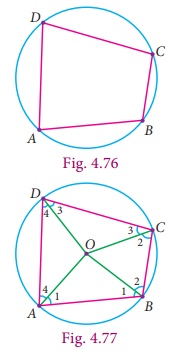
Thus, we
get from the figure,
2×( ∠ 1+ ∠
2+ ∠ 3+ ∠
4) + Angle at centre O = 4× 180°
2×(∠ 1+∠
2+∠ 3+∠
4) + 360°
= 720°
Simplifying
this,
( ∠ 1+ ∠
2+ ∠ 3+ ∠
4) = 180°.
You now interpret this as
(i) (∠ 1+∠ 2) + (∠ 3+∠ 4) = 180° (Sum of opposite angles B
and D)
(ii) ( ∠ 1+ ∠ 4) + ( ∠ 2+ ∠ 3) = 180° (Sum of opposite angles A
and C)
Now the result
is given as follows.
Theorem 12 Opposite angles of a cyclic
quadrilateral are supplementary.
Let us see
the converse of theorem 12, which is very useful in solving problems
Converse of Theorem 12 If a pair
of opposite angles of a quadrilateral is supplementary, then the quadrilateral is
cyclic.
Activity − 7
Procedure
1. Draw a circle of any radius with centre O.
2. Mark any four points A,
B, C and D on the boundary. Make
a cyclic quadrilateral ABCD and name
the angles as in Fig. 4.78
3. Make a replica of the cyclic quadrilateral ABCD with the help of tracing paper.
4. Make the cutout of the angles A, B, C and D as in Fig.
4.79
5. Paste the angle cutout ∠1, ∠2, ∠3 and ∠4 adjacent to the angles
opposite to A, B, C and D as in Fig. 4.80
6. Measure the angles ∠1 + ∠3, and ∠2 + ∠4.
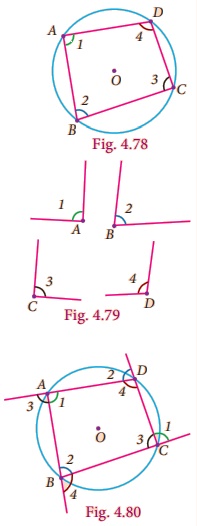
Observe and complete
the following:
1. (i) ∠A + ∠C =
(ii) ∠B + ∠D =
(iii) ∠C + ∠A =
(iv) ∠D +∠B =
2. Sum of opposite angles of a cyclic quadrilateral is 180°.
3. The opposite angles of a cyclic quadrilateral is _______.
Example 4.10
If PQRS
is a cyclic quadrilateral in which ∠PSR = 70° and ∠QPR = 40°, then find ∠PRQ (see Fig. 4.81).
Solution
PQRS is a cyclic quadrilateral
Given ∠ PSR
= 70°
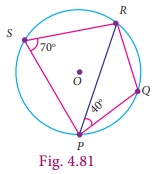
∠PSR
+
∠PQR =
180° (state reason________)
70° +
∠PQR = 180°
∠PQR = 180° − 70°
∠PQR = 110°
In ΔPQR we have,
∠PQR
+
∠PRQ +
∠QPR =
180°
(state reason_________)
110° +
∠PRQ + 40° = 180°
∠PRQ = 180° − 150°
∠PRQ = 30°
Exterior Angle of a Cyclic Quadrilateral
An exterior
angle of a quadrilateral is an angle in its exterior formed by one of its sides
and the extension of an adjacent side.
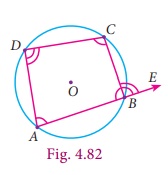
Let the side
AB of the cyclic quadrilateral ABCD be extended to E. Here
∠ABC and ∠CBE are
linear pair, their sum is 180° and the angles ∠ABC and ∠ADC are
the opposite angles of a cyclic quadrilateral, and their sum is also 180°.
From this, ∠ABC + CBE = ∠ABC + ADC and finally we get ∠CBE = ∠ADC . Similarly it can be proved for other
angles.
Theorem 13 If one side of a cyclic quadrilateral is produced then the exterior
angle is equal to the interior opposite angle.
Progress Check
1. If a pair of opposite angles of a quadrilateral is supplementary,
then the quadrilateral is _____________.
2. As the length of the chord decreases, the distance from the centre
_____________.
3. If one side of a cyclic quadrilateral is produced then the exterior
angle is _____________ to the interior opposite angle.
4. Opposite angles of a cyclic quadrilateral are _____________.
Example 4.11
In the figure
given, find the value of x° and y°
.
Solution
By the exterior
angle property of a cyclic quadrilateral,
we get, y°=100°
and
x° +
30° = 60°
and so x° =
30°
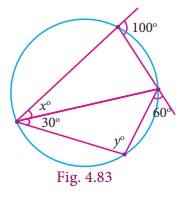
Related Topics